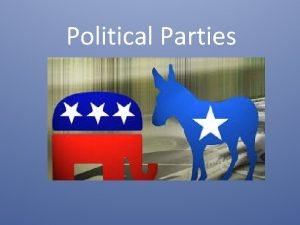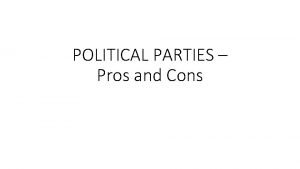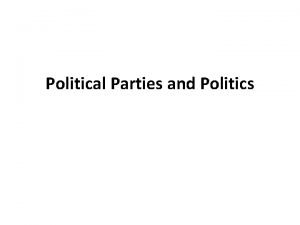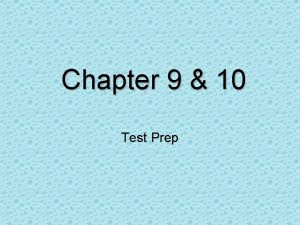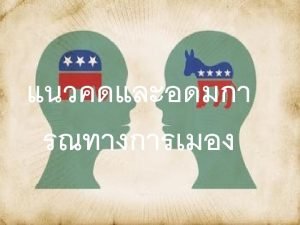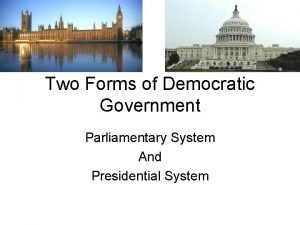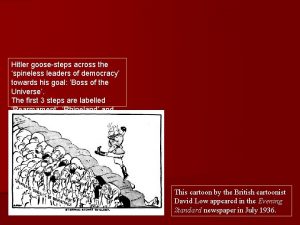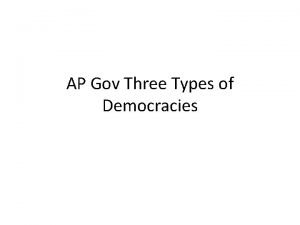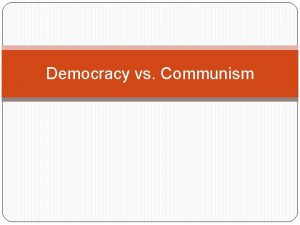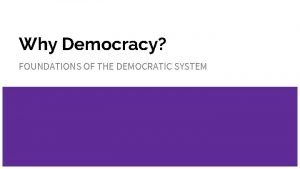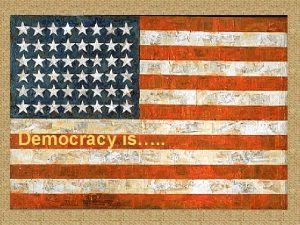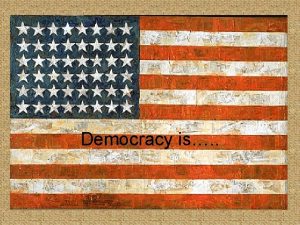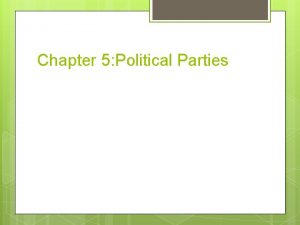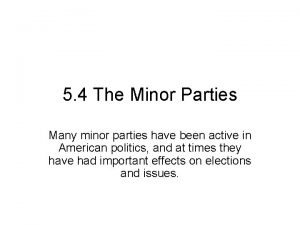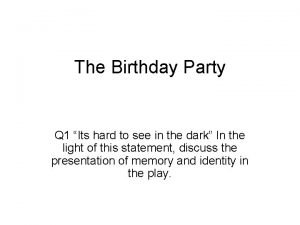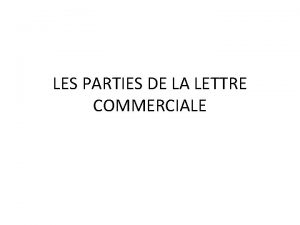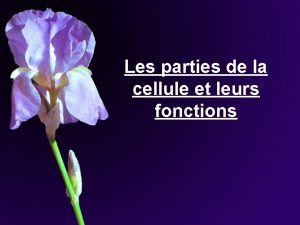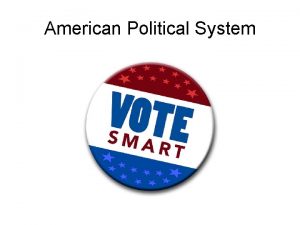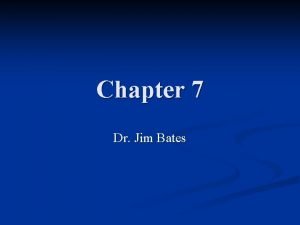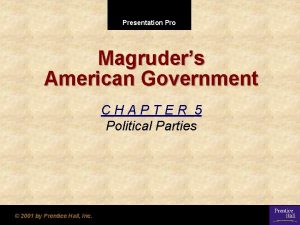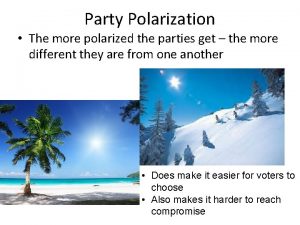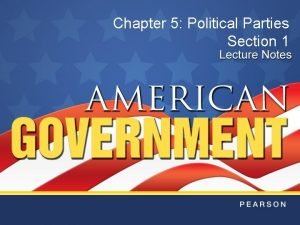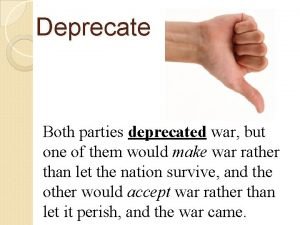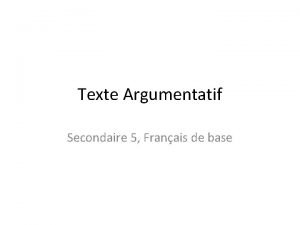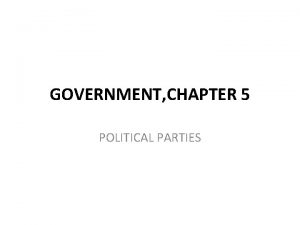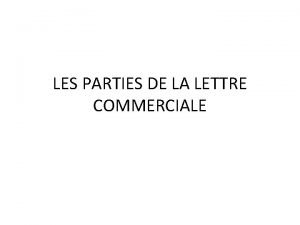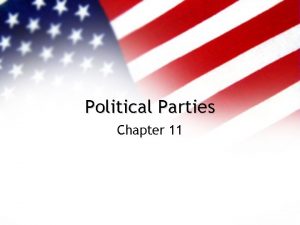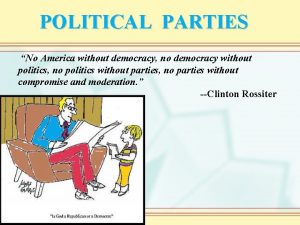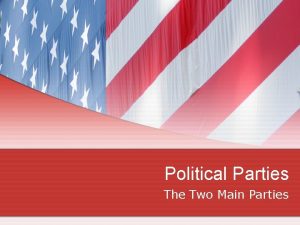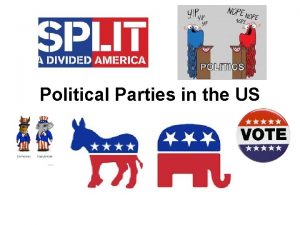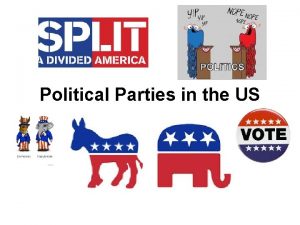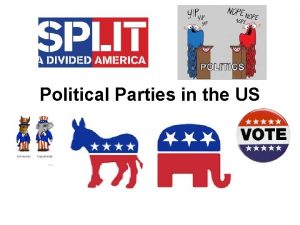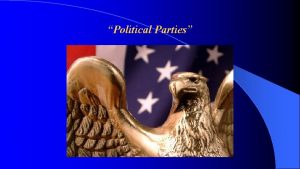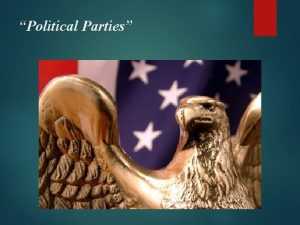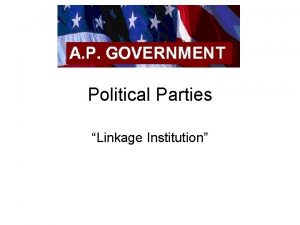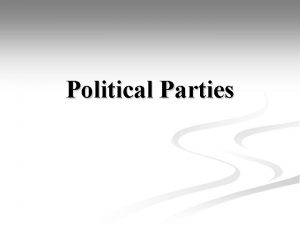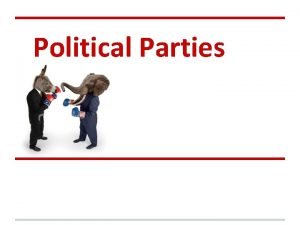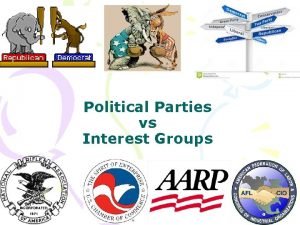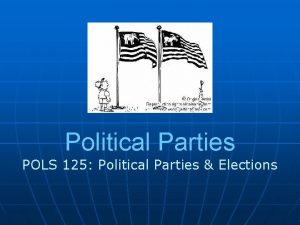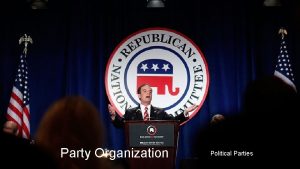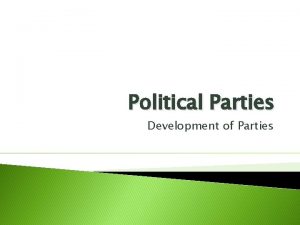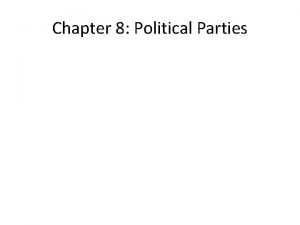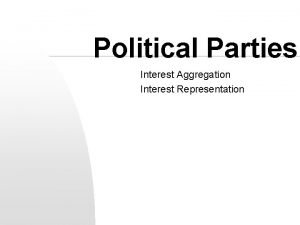POLITICAL PARTIES No America without democracy no democracy















































- Slides: 47

POLITICAL PARTIES “No America without democracy, no democracy without politics, no politics without parties, no parties without compromise and moderation. ” --Clinton Rossiter

Political Parties - Definition Political Parties ØA group of political activists who organize to win elections, operate the government, and determine public policy. 4 -2

4 -3

History of U. S. Party Politics Founding Period Federalists vs Antifederalists • issues – size and power of national government • base – Federalists primarily merchant/commercial/wealthy – Antifederalists primarily small farmer/craftsmen and south George Washington viewed political parties as a threat to national unity and popular government 4 -4

History of U. S. Party Politics Parties were not mentioned in the Constitution and did not exist in any recognizable form in the pre-party period, which lasted through Washington’s first term of office. 4 -5

4 -6

Why Does the United States Have a Two-Party System? • There have been many minor parties in American history. • There are many reasons why only parties have alternated in power in the United States for more than 125 years. 4 -7

The U. S. is a two-party system; most other democracies have a multiparty system Multiparty § Coalition government is necessary § Minor parties have an incentive to persevere § Proportional representation § Governments tend toward instability Two Party • Winner-takes-all system • “Wasted vote” syndrome discourages minor parties • Government tends toward stability • Policy change is incremental 8 -8

Why Does the United States Have a Two-Party System? (Cont’d) • The parties retain their strength nationally in large part because of the presidency, but party politics on the state and local levels often functions quite differently. • Most Americans readily identify with one of the two major parties. 4 -9

Why has the 2 -PARTY system endured? Often, on major issues confronting the country there have been two clear sides. This duality helped to initiate a two-party system and has maintained this system through the present. Ø Political socialization and practical considerations Ø The Winner-Take-All Electoral System 1. Presidential Voting 2. Popular Election of the Governors and President 3. Proportional Representation Ø State and Federal Laws Favoring the Two Parties 4 -10

Role of Third Parties Barriers to Minor-Party Success • Consensus • History • Tradition • History 4 -11

Minor Parties: Persistence and Frustration TYPE q. Ideological Parties q. Protest Parties q. Single Issue Parties q. Splinter Parties EXAMPLES q. Libertarian Party q. Green Party q. Reform Party 8 -12

Third Parties Many political scientists contend that third parties have acted as barometers of changes in the political mood. Third parties have influenced American politics by getting their policies adopted by a major party & determining whether the Republicans or Democrats win an election. 4 -13

Successful Third Parties 4 -14

The Party System Today • The present party system, featuring the Democratic and Republican parties, developed in the late 1850 s. • Three critical elections—elections that elections produced a sharp change in patterns of party loyalty among voters and lasting electoral realignment—have marked the present party system. 4 -15

THREE CRITICAL ELECTIONS ØThe Election of 1860 Ø The Election of 1896 Ø The Election of 1932 4 -16

ELECTION of 1860 8 -17

Election of 1896 4 -18

ELECTION of 1932 4 -19

Two-Party System in American History 4 -20

Political Parties - Functions Although many people regard political parties with suspicion, parties are an essential component of democratic government. 4 -21

Political Parties and Their Functions (Cont’d) Citizens’ main avenue of participation in government is through voting in competitive elections. Parties perform five important functions for the political system Candidate Recruitment (Nominations) Organizing and Running Elections Presenting Alternatives to Electorate Operating the Government Providing Organized Opposition to Government 4 -22

Five Important Functions - 1 1. Candidate Recruitment • Parties need to find viable candidates for a whole range of elected positions at the federal and state level • Obstacles to recruitment include: • time, privacy, finances, prospects 4 -23

Five Important Functions - 2 2. Organizing and Running Elections Provides: qresources for candidates qideas for candidates 4 -24

Five Important Functions - 3 3. Presenting alternatives to the electorate • Voters need choices among candidates and among policy alternatives q. Democratic Party Platform q. Republican Party Platform 4 -25

Five Important Functions - 4 4. Operating the government • legislative leadership positions • executive appointments • judicial appointments 4 -26

Five Important Functions - 5 Providing organized “loyal” opposition to government (minority party or parties only) • Make sure, if not in power, that party is ready for next election • leaders • issues • policies 4 -27

Party Candidates for the U. S. House in the 2002 Election 4 -28

PARTY IDENTIFICATION q During the last half-century, the Democrats have been known as the party of the working class and of racial and ethnic minorities. q During the last half-century, the Republicans have been known as the party of business and known for having an ethic of self-reliance. q Republicans have emphasized the importance of the marketplace and less emphasis on social programs. • . 4 -29

q Democrats have emphasized social welfare and protection of senior’s benefits. q In recent years, cultural issues have become increasingly important in defining the differences between the parties. [Abortion, Stem Cell, Same Sex Marriage] 4 -30

Distribution of Party Identification 1952 -2004 8 -31

Party Identification by Social Groups 4 -32

Party Ideology and Organization • Contrary to what many people believe, the Democrats and Republicans differ considerably in political ideology. • The difference can be seen in the way voters classify themselves on a liberal-conservative continuum. • Another way to see ideological differences is to analyze party platforms. 4 -33

Party Ideology and Organization (Cont’d) Despite their ideological differences on: Ø issues of freedom Ø order Ø Equality the parties are similar in that they are both capitalist parties that reject government ownership of the means of production. 4 -34

POLITICAL DIFFERENCES What are the Differences between Democrats and Republicans? A. Differences in core membership B. Differences in public policy 4 -35

A. Differences in Party Identifiers Core Democratic and Republican support by: § Race § Religion § Education § Economic Status § Geography 4 -36

B. Differences in Public Policy § Balancing Liberty (Freedom) with Equality § Balancing Liberty (Freedom) with Security (Order/Authority) 4 -37

Republican Issues and Democratic Issues 4 -38

POLITICAL ISSUES Liberals Equality Conservatives Liberty “Should the Government Increase Taxes on the Wealthiest Americans? ” Liberals—Yes Conservatives—No 4 -39

POLITICAL ISSUES Liberals Equality Conservatives Liberty “Should the federal government guarantee all Americans health care? ” Liberals—Yes Conservatives—No 4 -40

POLITICAL ISSUES Liberals Liberty Conservatives Security “Should the government de-criminalize the use of marijuana? ” Liberals—Yes Conservatives—No 4 -41

POLITICAL ISSUES Liberals Liberty Conservatives Security “Should the Congress extend provisions of the Patriot Act? Liberals—No Conservatives—Yes 4 -42

Party Ideology and Organization (Cont’d) • American parties parallel our federal system, having separate national and state organizations. • The national organization is not hierarchical and has little control over state party organizations. 4 -43

NATIONAL LEVEL ORGANIZATIONS Each major party has four main organizational components. 1. 2. 3. 4. A national convention A national committee Congressional party conferences Congressional campaign organizations 4 -44

NATIONAL PARTY PLATFORMS 8 -45

The Model of Responsible Party Government Four principles of responsible party government: 1. Parties should present clear and coherent programs to voters. 2. Voters should choose candidates on the basis of party programs. 3. The winning party should carry out its program once in office. 4. Voters should hold the governing party responsible at the next election for executing its program. 4 -46

ASSIGNMENT q. Map of U. S. Coloring the Blue and Red States from the 2014 midterm election Ø Landscape; heading at bottom Ø Legend to the bottom-right q. Graphic Organizer- 1 page typed paper comparing and contrasting the basic principles of the Democratic and Republican parties. 4 -47
 Political parties
Political parties Political parties
Political parties Political parties
Political parties Political parties pros and cons
Political parties pros and cons Brainpop voting
Brainpop voting Political party
Political party What was one way progressives differed from populists
What was one way progressives differed from populists Sistemas democraticos
Sistemas democraticos Parliamentary system vs presidential system
Parliamentary system vs presidential system Spineless leaders of democracy meaning
Spineless leaders of democracy meaning Types of democracies ap gov
Types of democracies ap gov Democracy vs communism political cartoon
Democracy vs communism political cartoon Make a poster that depicts the political democracy today
Make a poster that depicts the political democracy today Democracy cartoon drawing
Democracy cartoon drawing Direct democracy political cartoon
Direct democracy political cartoon Latin america map physical features
Latin america map physical features Without title for my father who lived without ceremony
Without title for my father who lived without ceremony Without rush without engines poetic device
Without rush without engines poetic device What is the theme of without title
What is the theme of without title Whats an onomatopeia
Whats an onomatopeia Why is latin america called latin america
Why is latin america called latin america Rap of the states
Rap of the states Performance e body art
Performance e body art North america south america asia europe africa
North america south america asia europe africa Power point parties
Power point parties Sarah and pam often go to parties
Sarah and pam often go to parties Corps dauphin
Corps dauphin Foods party
Foods party Splinter parties definition
Splinter parties definition Umbo membrana tympani
Umbo membrana tympani 4 types of minor parties
4 types of minor parties Microscope optique
Microscope optique Essay on birthday party in 200 words
Essay on birthday party in 200 words Horses hate surprise parties
Horses hate surprise parties Les parties du texte narratif
Les parties du texte narratif Internal and external issues template
Internal and external issues template Les parties de la lettre commerciale
Les parties de la lettre commerciale Réticulum endoplasmique lisse et rugueux
Réticulum endoplasmique lisse et rugueux Socialist parties
Socialist parties Why does gatsby stop giving parties?
Why does gatsby stop giving parties? Chapter 5 section 1 parties and what they do
Chapter 5 section 1 parties and what they do What does the graph indicate?
What does the graph indicate? Chapter 5 section 1 parties and what they do
Chapter 5 section 1 parties and what they do Deprecate in a sentence
Deprecate in a sentence Why is gatsby’s love for daisy doomed to fail? *
Why is gatsby’s love for daisy doomed to fail? * Comment annoter un texte argumentatif
Comment annoter un texte argumentatif Economic protest parties definition
Economic protest parties definition Les différentes parties de la lettre commerciale
Les différentes parties de la lettre commerciale

